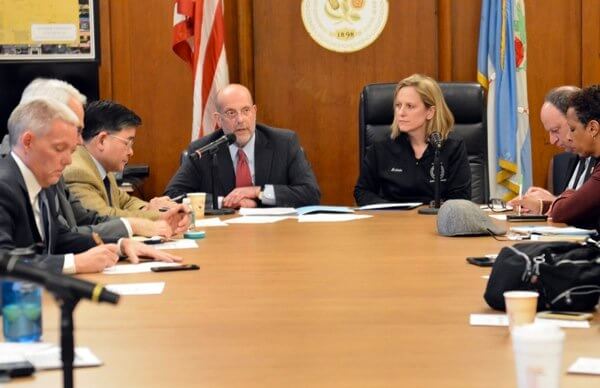By Naeisha Rose
City council members throughout Queens were at Borough Hall in Kew Gardens Monday to learn more about the homeless crisis in the county and the city from the Department of Social Services Commissioner Steve Banks ,
In Queens there are 10,513 people housed in shelters and only 8,731 individuals are from the borough, Banks said. Most of the homeless people from the borough are homeless because of the Great Recession (2007-2013).
Homelessness rose across the city by 38 percent from 2011 to 2014, according to Banks. Rent went up by 18.4 percent from 2005 to 2015, but wages only increased by 4.8 percent in the same time frame.
“If you have rent exceeding incomes, you’ll have homelessness,” said Banks.
Overall more than 60,000 people are in the shelter system across the city, he said.
Together with Mayor Bill de Blasio, the commissioner wants to use a four pillars approach to homelessness. The goals are homeless prevention, bringing people off the streets, finding housing for people who are homeless and transforming the way the city provides shelters.
For the last initiative, the idea is to keep people who are homeless within a shelter close to their community in their borough, according to Banks. Only people with special circumstances like domestic violence survivors and those with special needs may be sheltered outside the borough they are from.
According to the commissioner, nearly 70 percent of families with minor children are homeless and 34 percent of those families have one adult who is working.
Some of the reasons for the community borough approach to housing ARE to keep children near their school district and to keep families near medical providers and religious advisors, said Banks.
He also addressed the use of hotels and cluster sites for housing the homeless.
DSS wants to close all hotels and cluster sites and replace them with 90 smaller unit shelters throughout the city. The shelter will have 50 to 250 units.
In Queens there are 69 shelters: 28 are traditional permanent shelters, while 41 are hotels that are fully rented or semi-rented out by the city housing nearly 5,000 people, said Banks.
Of the 90 shelters that will roll out, 11 are open and have community advisory boards managing them and six will open later this year. Only one of the six to open will be in Queens.
Before the housing insecure are shuffled into a shelter from a cluster site or hotel, they will be given 30 days’ notification. In the past they were given 24 hours.
The city will also use eminent domain to convert 25 to 30 of the cluster sites and hotels into shelters and finance nonprofits to operate them, and that should provide 800 families with homes, Banks said.
The city will also bring back rental assistance programs, which should keep 70,000 people in their homes.
Councilwoman Adrienne Adams (D-Jamaica) was less concerned about a borough plan for housing, and wanted to learn more about equity in terms of where shelters are placed.
According to the councilwoman, Community Board 12 in Jamaica was burdened with the most shelters in the city.
Banks said that although the hotels that are operating as shelters are going to be phased out, housing everyone in a shelter the new shelters is not going to happen immediately with the new program.
“I may infuriate you,” said Banks, but “ultimately the plan will have a vision we will all embrace.”
Reach reporter Naeisha Rose by e-mail at nrose

































